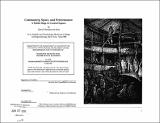| dc.contributor.advisor | William Porter. | en_US |
| dc.contributor.author | De Sola, David Theodore | en_US |
| dc.coverage.spatial | n-us-ma | en_US |
| dc.date.accessioned | 2011-09-13T17:41:02Z | |
| dc.date.available | 2011-09-13T17:41:02Z | |
| dc.date.copyright | 1995 | en_US |
| dc.date.issued | 1995 | en_US |
| dc.identifier.uri | http://hdl.handle.net/1721.1/65710 | |
| dc.description | Thesis (M.C.P.)--Massachusetts Institute of Technology, Dept. of Urban Studies and Planning; and, (M.Arch.)--Massachusetts Institute of Technology, Dept. of Architecture, 1995. | en_US |
| dc.description | Includes bibliographical references (p. 143-146). | en_US |
| dc.description.abstract | In this thesis I strive to explore the question, "what is good architecture?" through the design of a facility for formal and informal musical and theatrical performance. The site for this project is in Central Square, Cambridge, Massachusetts, on the Southeast comer of Massachusetts Avenue and Prospect Street. The program of the design includes a multi-use theater supported by first and second level commercial retail space, a multi-floored office space, and integrated subway station, each included to encourage pedestrian traffic and generate revenue. Additionally, the facility includes a jazz club, a folk room, and a rock club. The final product is a hybrid of existing facilities and ideas developed with prospective facility users; I have made efforts to take advantage of the knowledge and ideas of some users in determining the program and design. The facility aims to encourage and facilitate community integration with use-specific and non-use specific elements. It aims to strengthen the pattern of public gathering now inhibited by the spatial arrangement of the area. Among the important areas of inquiry, I focus considerable attention on the outdoor and semi-outdoor public space of the facility. The design intends to generate an eddying effect on the linear flow of pedestrian traffic down Massachusetts Avenue. By providing areas for street performers with sheltered seating and standing areas for itinerant audiences, this space intends to take on a theatric and communal character. To achieve the goals set out above I have drawn upon a process involving design, theory, and precedent models falling under three main categories. Design Precedents: -Theaters; -Music Halls; -Night Clubs. Organizational Design Precedents: -User Involved Design Tools; -User Involved Design Precedents. Inventive Programming Precedents: -Personal Account of Inventive Process; -Case investigation. | en_US |
| dc.description.statementofresponsibility | by David Theodore de Sola. | en_US |
| dc.format.extent | 151 p. | en_US |
| dc.language.iso | eng | en_US |
| dc.publisher | Massachusetts Institute of Technology | en_US |
| dc.rights | M.I.T. theses are protected by
copyright. They may be viewed from this source for any purpose, but
reproduction or distribution in any format is prohibited without written
permission. See provided URL for inquiries about permission. | en_US |
| dc.rights.uri | http://dspace.mit.edu/handle/1721.1/7582 | en_US |
| dc.subject | Urban Studies and Planning | en_US |
| dc.subject | Architecture | en_US |
| dc.title | Community, space, and performance : a public stage in Central Square | en_US |
| dc.type | Thesis | en_US |
| dc.description.degree | M.Arch. | en_US |
| dc.description.degree | M.C.P. | en_US |
| dc.contributor.department | Massachusetts Institute of Technology. Department of Architecture | |
| dc.contributor.department | Massachusetts Institute of Technology. Department of Urban Studies and Planning | |
| dc.identifier.oclc | 41235873 | en_US |
